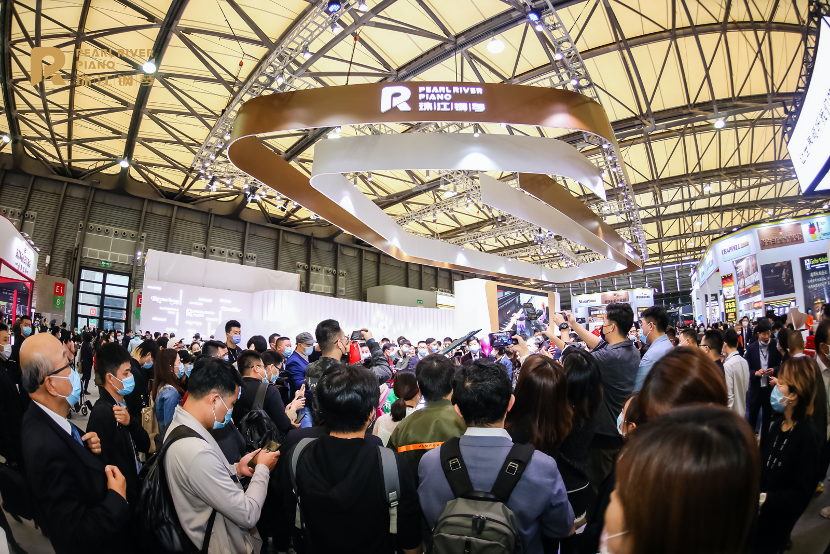Recently, Pearl River Piano Group looked to the future with its first grand piano using 3D printer technology With a wink in the direction of space travel, this wing is entirely inspired by Michael Jackson’s Moonwalk – a showcase of imagination. PIANIST talked with Leng Tshua, Global Sales and Marketing Director of Pearl River Piano Group.

The grand piano was unveiled at Music China, Asia’s largest music trade show. The four-day event in Shanghai attracted more than 11,000 visitors from 81 countries. Kayserburg’s “Celestial Harmony Spacewalk” stole the show among the 2,252 exhibitors from 31 countries. Founded in 1956, the Pearl River Piano Group is now the world’s largest piano manufacturer, producing more than 150,000 instruments a year and holding a good 30 percent market share worldwide. Pearl River Piano Group produces three brands: Pearl River, Ritmüller and Kayserburg.
The process of 3D printing is revolutionary because it enables designs that would be difficult to construct using traditional production methods. Although the cast iron frame and wooden structure of the piano are retained, the body was printed from carbon fiber polyester. This “Celestial Harmony Spacewalk” is based on the Kayserburg GH188A and the results of advanced CNC processes combined with 3D printer technology.

When did you have the idea to work with 3D printer technology? We have been looking at the potential of 3D manufacturing for several years now.
In your press release, you refer to developments in the automotive industry that are taking place in 3D technology from aircraft manufacturers. Is it typical of true innovation to look outside your own industry?
We need to look beyond the piano industry if we are to make the transition into the new millennium, as our end users are significantly different from those of 60 years ago. The new generation of consumers is growing up with smartphones, and we must also integrate this technological platform into our future products.
In the past, things like self-driving cars would have been considered completely impossible. Today there is. Will the same be true for a 3D-printed wing? How far do you think this development will go? Just look how fast smartphones have evolved and how we always have to carry them with us wherever we go! We are always looking for new technologies that could promote and improve our manufacturing process.
Could we say that this is the ultimate step in piano design, a result of earlier developments in the field of carbon mechanics, for example? Or is it just the next step, and we don’t know where creativity and ingenuity will take us in the future?
Given the infinite potential in 3D printing technology, our first step is to test the possibilities of manufacturing acoustic instruments with such a high-tech platform. And should this become reality in the near future, it could revolutionize the industry in a positive sense.
As you know, the design and manufacture of the rim is something that distinguishes great piano makers from others. One only has to consider the great differences between Bösendorfer and Steinway, which lead directly to a different concept of sound. How do you see the printed Rim in this context?
I agree that the rim as well as other parts of the piano ‘are the vital organs of the construction and must not be interfered with. We are very selective in such a process, and our ultimate goal is to make a great sounding acoustic piano.
How is the sound received?
The piano we exhibited at Music China 2020 was played by professional musicians and other industry experts, and the feedback was very positive. I consider this approach to be successful.
Does 3D printer technology make production easier? Do you need less time and manpower?
3D printer technology definitely makes production “easier” and it is possible in less time. But there is still a need for real people who work together in the best harmony with the machines!
Does this method of production also influence the “feeling” and appreciation that customers have for the unique characteristics of a musical instrument? So to what many see as his “soul”? We are aware that we are manufacturers of acoustic pianos. Our intention in everything is “form follows functions” to keep the soul alive!
Do you think 3D printing technology will be an integral part of Pearl River’s piano production in the future?
Since we have just taken the first step into a futuristic concept, we are exploring the market potential that arises as a result of Music China 2020. I think that in a few years we may be able to announce realistic plans on how to offer such 3D-printed pianos in selected areas.
Can this also be applied to pianinos?
Yes, this can definitely happen! You also use plexiglass, what else is new about this design? We are currently investigating other materials that are suitable for the piano in terms of their acoustic possibilities.
How many pianos should be made?
We do not yet have a forecast, but we are prepared to accept special orders from potential interested parties.
Will we soon see a piano from the 3D printer in Europe?
Definitely! If the interest in Europe is strong enough and we are invited, I could imagine a European tour of the 3D-printed piano in the foreseeable future.

www.pianist-magazin.de